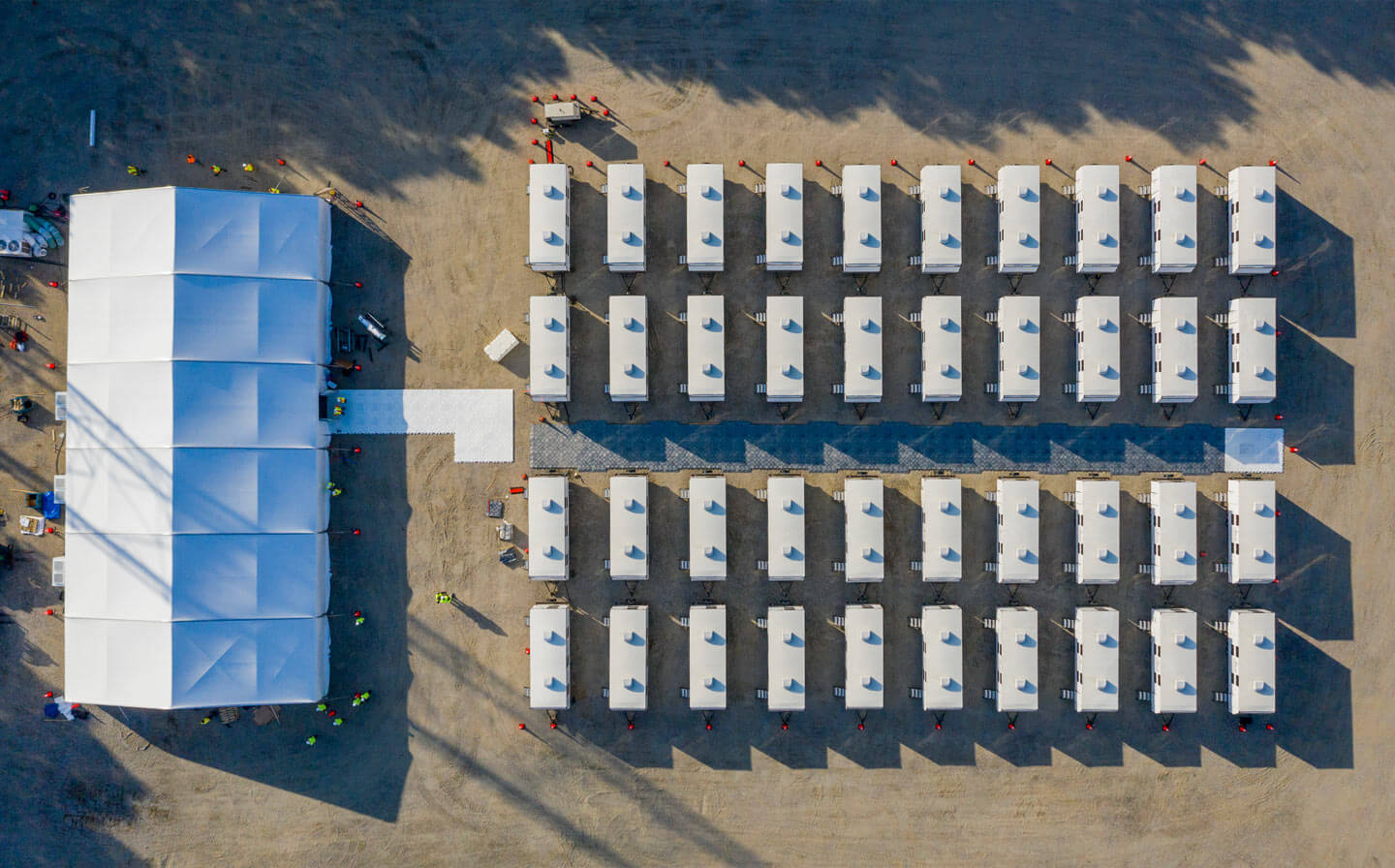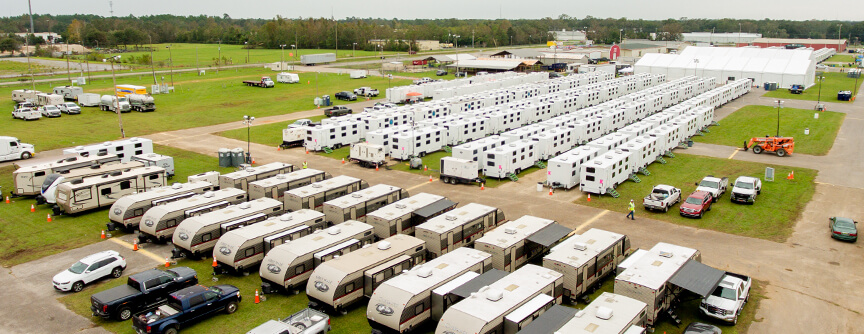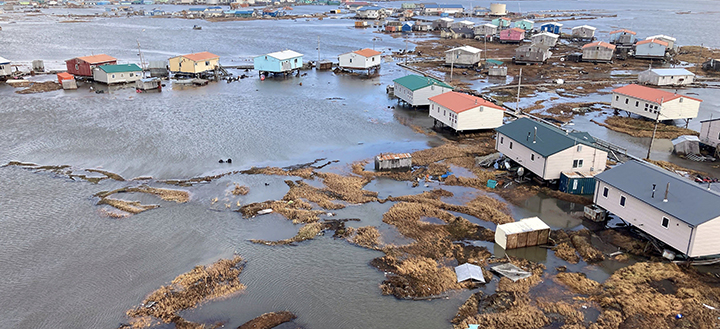Post-disaster shelters provide food, water, and temporary housing to communities affected by disasters.
For emergency managers and response teams, operating these shelters when staffing is limited or supplies run low is a significant challenge. Planning for these situations helps shelters maintain operations even under high demand.
This article highlights common challenges faced by post-disaster shelters and outlines practical strategies for managing staffing, supplies, and operational capacity. It also describes how MLU Services can support disaster response efforts.
Understanding Post-Disaster Shelter Resource Challenges
Post-disaster shelters provide safe spaces for evacuees when homes are damaged or uninhabitable. With disasters increasing in frequency and intensity, even well-prepared facilities can reach limits on staff and supplies.
As events progress, additional services such as health care, mental health support, and childcare may be required. Shortages in personnel or supplies can directly affect these services, creating operational strain and potential risks for residents.
Staffing Shortages

Staffing is one of the most unpredictable aspects of operating a post-disaster shelter. Unlike physical supplies, personnel cannot be stockpiled and require coordination, training, and availability at the exact time they are needed. Large-scale disasters can make qualified staff, especially those experienced with vulnerable populations, hard to find, as noted in the HUD Exchange disaster response guide.
The FEMA Shelter Field Guide outlines that every post-disaster shelter should include a shelter manager, shift supervisors, and staff responsible for recruiting, orienting, training, and tracking personnel.
Staff shortages become particularly acute when disasters affect multiple jurisdictions. Local staff may be managing their own household emergencies, and mutual aid agreements can be stretched when neighboring communities face similar challenges.
Emergency managers should develop contingency plans that account for reduced staffing levels while maintaining operational standards.
Strategies to Address Staffing Shortages
- Consultants and Staff Augmentation Services: Consultants with staff augmentation experience can provide trained personnel, guidance on safety protocols, and shelter management support. They can quickly integrate new staff into post-disaster shelters and assist with training in trauma-informed care and operational procedures.
- Recruiting Volunteers: Engaging the local community can be an effective way to bolster staff numbers. Clear communication about the shelter’s needs, ranging from administrative roles to food preparation, can encourage the participation of willing volunteers.
- Utilizing Resident Volunteers: Residents of post-disaster shelters can assist with non-specialized tasks, such as cleaning or meal distribution. Training them for specific duties can help maintain operations while encouraging a sense of shared responsibility.
- Partnering with External Organizations: Collaborations with non-government organizations (NGO) and local community groups provide access to trained personnel during emergencies. These partnerships can expand staffing resources when local personnel are limited.
- Base Camps for Responders: When local staffing is unavailable, base camps established by providers such as MLU Services can house Incident Management Teams (IMTs), Emergency Operations Center (EOC) staff, and other support personnel from outside the area. While MLU Services typically does not directly staff post-disaster shelters, their logistical support enables responders to effectively accommodate themselves and maintain operations.
Supply Chain Disruptions

Post-disaster shelters need a steady supply of food, water, medical resources, sanitation equipment, and hygiene kits.
However, prolonged emergencies can quickly drain initial inventories, leaving shelters struggling to meet basic needs.
Strategies for Managing Supply Shortages
- Pre-Disaster Stockpiling: Emergency planners should maintain supply inventories based on the population each post-disaster shelter is expected to serve. FEMA recommends including food, water, hygiene items, blankets, and medical supplies in these inventories. This should include plans for rotation of perishable items, such as donation of supplies before the expiration date and identification of resources and funding for replenishment.
- Community and NGO Support: Shelters may receive additional resources from local donations and NGOs. To manage these contributions effectively, shelters should implement clear donation protocols and encourage monetary contributions to allow targeted procurement.
- Establishing Supply Agreements: Formal arrangements with vendors before an emergency can streamline resupply efforts. For example, working with vendors to prioritize post-disaster shelter needs can mitigate delays in procurement during widespread emergencies.
- Leveraging Local and State Resources: EOCs can provide additional supplies through local agencies, vendors, or community contributions. Coordinating with these resources allows shelters to maintain operations under stress.
- Public Communication: Keeping residents informed about what to bring, such as personal emergency supply kits, can reduce pressure on shelter resources.
Dealing with Overcrowding

Post-disaster shelters are often designed for a set capacity, but large-scale disasters can push occupancy well beyond planned limits. Overcrowding creates operational, logistical, and safety challenges for staff and residents.
Strategies to Mitigate Overcrowding
- Plan for Overflow: Identify alternative facilities such as schools, community centers, or gyms that can function as temporary shelters if existing post-disaster shelters exceed capacity. It’s also important to be aware of fire codes to ensure these facilities are not exceeding safety limits.
- Adjust Services to Match Occupancy: Increase staff rotations and supply allocations based on the number of residents to maintain operational efficiency.
- Maintain Accessibility: Ensure that accommodations for individuals with accessibility needs are available when relocating residents to alternate facilities.
- Expand Capacity with Temporary Sites: Coordinate with local EOCs to establish additional shelters. Pop-up sites, such as those described in the FEMA Shelter Field Guide, can provide immediate relief when permanent locations are full.
- Utilize a Clear Transportation Strategy: Move shelter populations safely while keeping families together to reduce stress and disruption.
- Communicate Overflow Policies: Provide clear instructions on where residents should go if a shelter reaches capacity to minimize confusion and maintain order.
Local and State Post-Disaster Shelter Best Practices
Effective management of post-disaster shelters requires adapting state and local emergency shelter guidelines to fit community needs and available resources. Successful operations depend on coordination across multiple systems and agencies.
Operational management practices include:
- Clear intake and registration procedures
- Resource tracking and inventory management
- Streamlined communication and information sharing
- Security and safety protocols
Coordination mechanisms are also important. These include multi-agency procedures, resource-sharing agreements, volunteer management systems, and partnerships with community organizations. Implementing these practices allows post-disaster shelters to maintain operations efficiently during emergencies.
The Role of Base Camps in Supporting Disaster Response Operations

While emergency shelters serve displaced populations, base camps provide accommodation for response personnel working in affected areas. When disasters overwhelm local resources, IMTs, utility crews, volunteer groups, and first responders need places to stay to maintain operational effectiveness.
High-disaster locations such as Florida and California have developed comprehensive plans for establishing base camps to support response operations. However, areas with lower disaster frequency often lack adequate planning for these facilities, creating challenges when large-scale events occur and outside assistance arrives.
Base camps differ fundamentally from shelters in their purpose and operations. While shelters focus on providing safety and basic services to survivors, base camps support the logistics of response operations. These facilities typically provide sleeping accommodations, meals, communications, and equipment staging areas for professional responders.
The establishment of base camps becomes particularly important when local hotel and lodging capacity is insufficient to accommodate the influx of response personnel. Specialized providers, such as MLU Services, can establish these facilities quickly, providing the infrastructure necessary to support extended response operations without competing with evacuees for shelter space.
Building Resilient Post-Disaster Shelters
Post-disaster shelters could face staffing shortages, supply limitations, or overcrowding, and preparing for these scenarios requires careful planning, clear communication, and efficient management of resources.
Emergency managers can strengthen shelter operations through coordination with government agencies, private partners, and community organizations. Planning and strategic partnerships allow post-disaster shelters to maintain functionality and respond effectively if these challenges arise.
If your organization is exploring ways to enhance sheltering capabilities and preparedness, our team can provide tailored support and solutions to meet your specific needs. Connect with us to discuss strategies that strengthen resilience in times of crisis.



